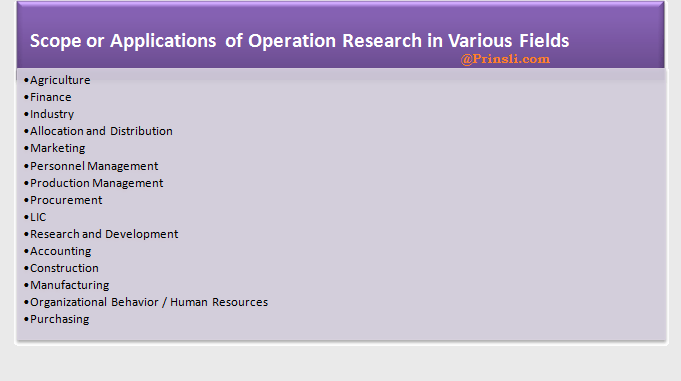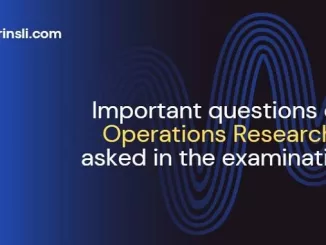
Scope / Applications of Operation Research in Various Fields –
In its recent years of organized development, O.R. has solved successfully many cases of research for the military, the government and industry. The basic problem in most of the developing countries in Asia and Africa is to remove poverty and hunger as quickly as possible. So there is a great scope for economists, statisticians, administrators, politicians and technicians working in a team to solve this problem by an O.R. approach.
Besides this, OR is useful in the following various important fields:
- In Agriculture:
With the explosion of population and consequent shortage of food, every country is facing the problem of-
-
- optimum allocation of land to various crops in accordance with the climate conditions; and
- optimum distribution of water from various resources like canal for irrigation purposes.
Thus there is a need of determining the best policies under the prescribed restrictions. Hence a good amount of work can be done in this direction.
- In Finance:
In these modern times of economic crisis, it has become very necessary for every government to have a careful planning for the economic development of her country. OR techniques can be fruitfully applied:
-
- to maximize the per capita income with minimum resources;
- to find out the profit plan for the company;
- to determine the best replacement policies, etc.
- In Industry:
If the industry manager decides his policies (not necessarily optimum) only on the basis of his past experience (without using OR techniques) and a day comes when he gets retirement, then a heavy loss is encountered before the Industry. This heavy loss can immediately be compensated by newly appointing a young specialist in OR techniques in business management. Thus OR is useful to the Industry Director in deciding the optimum allocation of various limited resources such as men, machines, materials, money, time, etc., to arrive at the optimum decision.
- In Allocation and Distribution:
-
- Optimal allocation of limited resources such as men, machines, and materials.
- Location and size of warehouses, distribution center, retail depot etc.
- Distribution policy.
- In Marketing:
With the help of OR techniques a Marketing Administrator (Manager) can decide:
-
- where to distribute the products for sale so that the total cost of transportation etc. is minimum;
- the minimum per unit sale price;
- the size of the stock to meet the future demand,
- how to select the best advertising media with respect to time, cost, etc.
- how, when, and what to purchase at the minimum possible cost?
- In Personnel Management:
A personnel manager can use OR techniques:
-
- to appoint the most suitable persons on minimum salary,
- to determine the best age of retirement for the employees,
- to find out the number of persons to be appointed on a full-time basis when the workload is seasonal (not continuous).
7. In Production Management:
A production manager can use OR techniques:
-
- to find out the number and size of the items to be produced;
- in scheduling and sequencing the production run by proper allocation of machines;
- in calculating the optimum product mix; and
- to select, locate, and design the sites for the production plants.
- In Procurement:
-
- What, when and how to purchase at minimum procurement cost
- Bidding and replacement policies
- In L.I.C.:
OR approach is also applicable to enable the LIC offices to decide:
-
- what should be the premium rates for various modes of policies,
- how best the profits could be distributed in the cases of with profit policies? etc.
- In Research and Development:
-
- Determination of the areas of concentration of Research and Development
- Reliability & control of the development of projects
- Selection of projects & preparation of their budgets.
- In Accounting:
-
- Assigning audit teams effectively
- Credit policy analysis
- Cash flow planning
- Developing standard costs
- Establishing costs for byproducts
- Planning of delinquent account strategy
- Construction:
-
- Project scheduling, monitoring and control
- Determination of proper work force
- Deployment of workforce
- Allocation of resources to projects
- Manufacturing:
-
- Inventory control
- Marketing balance projection
- Production scheduling
- Production smoothing
- Organizational Behavior / Human Resources:
-
- Personnel planning
- Recruitment of employees
- Skill balancing
- Training program scheduling
- Designing organizational structure more effectively
15. Purchasing:
-
- Optimal buying
- Optimal reordering
- Materials transfer
Also, OR techniques can be used in Defense Operations, Traffic control, In hospitals, etc. Finally, we can say: wherever there is problem, there is OR.
Read Also: Applications of Operation Research in Management
(Source – Various books of college library)
Copyrighted Material © 2019 - 2024 Prinsli.com - All rights reserved
All content on this website is copyrighted. It is prohibited to copy, publish or distribute the content and images of this website through any website, book, newspaper, software, videos, YouTube Channel or any other medium without written permission. You are not authorized to alter, obscure or remove any proprietary information, copyright or logo from this Website in any way. If any of these rules are violated, it will be strongly protested and legal action will be taken.




Be the first to comment